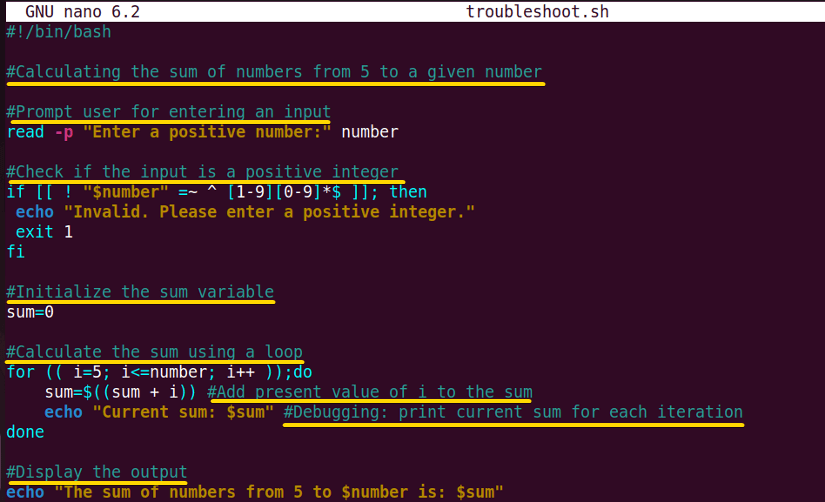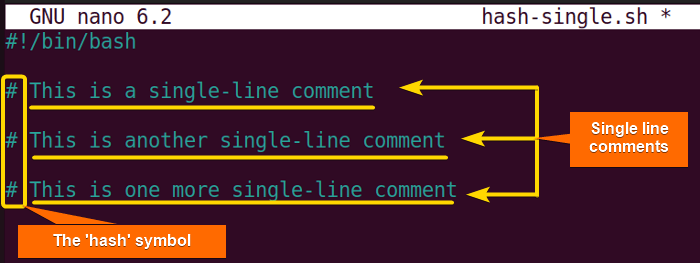FUNDAMENTALS A Complete Guide for Beginners

Single-line comments in a Bash script are the important annotation that makes the script more readable. You can use a single-line comment to add an explanation of codes or disable some particular codes for a while. So, let me turn your attention to this article which will provide a detailed interpretation of single-line comments in Bash to you.
Key Takeaways
- Learning about single-line comments in Bash.
- Getting ideas about some practical executions of single-line comments in Bash script.
Free Downloads
What Are Single Line Comments in Bash?
Single-line comments refer to the comments where the line starts with a hash symbol (#) and are placed before or after the code in the Bash script. These comments are kind of short and concise. Moreover, single-line comments are only for quoting a simple brief of code lines and are not executed by the interpreter or compiler.
2 Cases of Single Line Comments in Bash Scripting
Single-line comments are the less explanatory Bash comments. These are related to two points: i) Bash hashing, and ii) Inline comments. A little introduction to these two concerns is given below:
Case 1: Bash Hashing in Case of Single Line Comments
In Bash, hash (#) is the symbol for commenting out a line. A single-line comment prefixed with the hash symbol (#) adds an explanatory text without affecting the execution of codes within the Bash script. Following is an example of bash hashing in case of single-line comments with step by step procedure:
Steps to Follow >
- Open your Ubuntu Terminal.
- To open a script in the nano text editor, write the command below:
nano hash-single.shEXPLANATION- nano: A text editor.
- hash-single.sh: This is a script that you can name by any of your choices. Here, I have named the script by ‘hash-single.sh’.
- Hereafter, write the following script inside the editor:Script (hash-single.sh) >
#!/bin/bash # This is a single-line comment # This is another single-line comment # This is one more single-line commentEXPLANATIONHere, #!/bin/bash: ‘#!’ is called “Shebang” which is used for executing the bash script. The three lines ‘# This is a single-line comment’, ‘# This is another single-line comment’, and ‘# This is one more single-line comment’ dictate single-line comments as there is the hash symbol before each of these lines.
From the above image, you can see three single-line comments which are prefixed with the hash symbol.
Case 2: Inline Comments in Case of Single Line Comments
The single-line comments that are used at the end of the coded line are specifically called inline comments. These are used at the same line of the code starting with a hash sign without moving to the next line. Below is a simple example of inline comments in case of single-line comments:
Script (single-line.sh) >
#!/bin/bash
number=20
echo "The number is: $number" #Display the current number
number=$((number+5)) #Increment the ‘number’ variable
echo "The updated number is: $number" #Display the updated numberHere, the comment ‘#Display the current number’ indicates printing the present number. Then, ‘#Increment the ‘number’ variable’ tells to increase the value of the current number by 5. Finally, ‘#Display the updated number’ displays the updated number that is been increased.
 You can see the single-line comments as inline comments in the above image.
You can see the single-line comments as inline comments in the above image.
3 Practical Examples of Single-line Comments in Bash
Single-line comments can be of help in various practical schemes. Now, I am going to mention some real clarifications of single-line comments in the Bash script in the following section:
Example 1: Bash Single Line Comments for Troubleshooting
For any troubleshooting purpose within Bash scripts, debugging with single-line comments is quite helpful. Below is an example of single-line comments aiding in debugging:
Script (troubleshoot.sh) >
#!/bin/bash
#Calculating the sum of numbers from 5 to a given number
#Prompt user for entering an input
read -p "Enter a positive integer:" number
#Check if the input is a positive integer
if [[ ! "$number" =~ ^[1-9][0-9]*$ ]]; then
echo "Invalid input. Please enter a positive integer."
exit 1
fi
#Initialize the sum variable
sum=0
#Calculate the sum using a loop
for (( i=1; i<=number; i++ )); do
sum=$((sum + i)) #Add present value of i to the sum
echo "Current Sum: $sum" #Debugging: print current sum for each iteration
done
#Display the output
echo "The sum of numbers from 5 to $number is: $sum"Here, the initial comment ‘#Calculating the sum of numbers from 5 to a given number’ dictates the purpose of the script telling what is going to perform. Next, the comment ‘#Prompt user for entering an input’ informs the user that now they have to enter a positive integer. The single-line comment, ‘#Check if the input is a positive integer’ inside the if statement tells to ensure that the given number is a positive integer; if not there will be an error message.
Now, the comment ‘#Initialize the sum variable’ informs users of the initialization of the sum operation. Then, ‘#Calculate the sum using a loop’ states that a for loop will be running to find out the sum. After that, ‘#Add present value of i to the sum’ indicates the addition of the present value of ‘i’ and the sum variable for each iteration. Hereafter, ‘#Debugging: print current sum for each iteration’ describes the debugging purpose by printing the current value of the sum for each iteration. Finally, Stating by the comment ‘#Display the output’, the output format is displayed.
 You can observe the step-by-step results and identify the unexpected bugs within your codes using single-line comments like the snapshot above.
You can observe the step-by-step results and identify the unexpected bugs within your codes using single-line comments like the snapshot above.
Example 2: Bash Single Line Comments for Educational Purposes
You can use single-line comments for educational purposes too. These can serve as great documented resources for any kind of tutorial. Here is an easy implementation of single-line comments on finding the factorial of a given number:
Script (factorial.sh) >
#!/bin/bash
#Calculating the factorial of a given number
#Prompt user for entering an input
read -p "Enter a positive integer: " number
#Check if the input is a positive integer
if [[ ! "$number" =~ ^[1-9][0-9]*$ ]]; then
echo "Invalid input. Please enter a positive integer."
exit 1
fi
#Initialize the factorial variable
factorial=1
#Calculate factorial using a loop
for (( i=1; i<=number; i++ )); do
factorial=$((factorial * i)) #Multiply factorial with current value of i
done
#Display the output
echo "The factorial of $number is: $factorial"Here, the initial comment, ‘#Calculating the factorial of a given number’ indicates the overview of the script telling what is going to perform. Next, the comment ‘#Prompt user for entering an input’ informs the user that now they have to enter a positive integer. Then, the single-line comment ‘#Check if the input is a positive integer’ inside the if statement tells to ensure that the given number is a positive integer; if not there will be an error message.
Now, the comment ‘#Initialize the factorial variable’ informs users of the initialization of the factorial operation. Then, ‘#Calculate factorial using a loop’ states that a for loop will be running to find out the factorial. After that, ‘#Multiply factorial with current value of i’ explains to multiply the factorial variable with the present value of ‘i’ for each iteration. Finally, framing by the comment ‘#Display the output’, the output format is displayed.
 From the image, you can see that the single-line comments have turned the program quite easy explaining each section of the code.
From the image, you can see that the single-line comments have turned the program quite easy explaining each section of the code.
Example 3: Bash Single Line Comments for Security Purposes
Single-line comments emphasize the security of a Bash script. Here’s an example of single-line comments on restricting unauthorized access to the Bash script:
Script (security.sh) >
#!/bin/bash
#IMPORTANT: Confirm that only authorized users can access the script.
#This script performs sensitive operations & must be protected.
#Check if the user is authorized
if [[ "$user" != "admin" ]]; then
echo "Error! You cannot run this script."
exit 1
fiHere, the initial comment, ‘#IMPORTANT: Confirm that only authorized users can access the script.’ explains to ensure only authorized users to run the script. Then, the comment, ‘#This script performs sensitive operations & must be protected.’ defines that the script needs protection from unusual access as it contains sensitive data. Lastly, ‘#Check if the user is authorized’ specifies verifying the user’s authority while running the script using a conditional statement.
 The single-line comments underlined in the above image help to define the unusual users easily.
The single-line comments underlined in the above image help to define the unusual users easily.
Conclusion
To summarize, single-line comments as an essential feature serve to clarify codes or programming within a Bash script. So, count on this guide and make a practice of commenting out your code concisely.
People Also Ask
Related Articles
- The Art of Commenting in Bash
- Bash the Hash! – a Symbolic Feature of Bash Comment
- Multiple Line Comments in Bash [With Shortcut Keys]
- How to Use Block Comment in Bash? [2 Cases]
<< Go Back to Bash Comments | Bash Scripting Tutorial

 From the above image, you can see three single-line comments which are prefixed with the hash symbol.
From the above image, you can see three single-line comments which are prefixed with the hash symbol.



